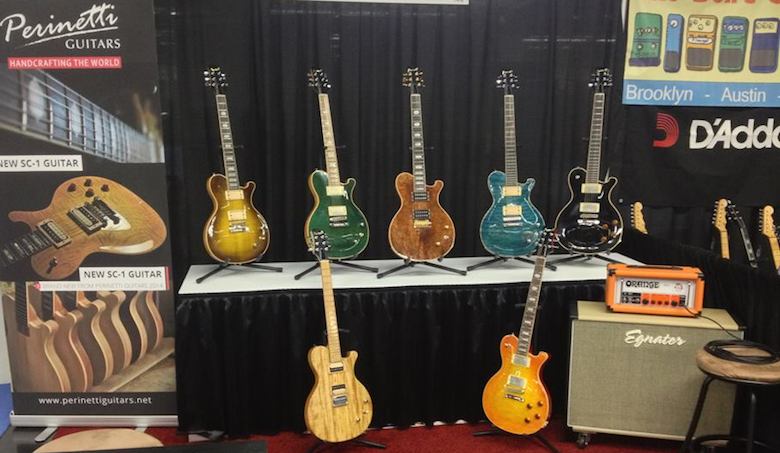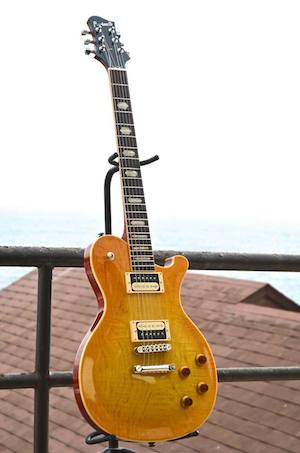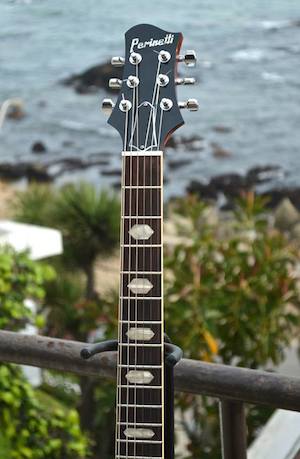Interview: Martin Frias of Perinetti Guitars
The first guitar that Martin Frias built wasn't a huge success, but that didn't stop him learning from the experience and building Perinetti Guitars, which exhibited at NAMM this year.

GH: How did you get started making guitars?
MF: I started 5 years ago when i got my hands on a mediocre luthier guitar, and i thought to myself "I bet i can make a better one, this looks like a pretty easy thing to do."
So i went to my local home center bought some tools and some wood and start working, with no knowledge or guidance. Turns out I couldn't make a better one nor it was an easy thing to do. But I loved it and got hooked right away. Then i got lucky that a guy called Gabriel was holding luthiery classes in my town, a very rare thing here, and to my knowledge the only one thats ever done it in Chile. So I started taking classes and progressing very fast due to my almost obsession to the craft. We decided to work together and started GMG Guitars. That unfortunately didn't work for different reasons, so we split and i started Perinetti Guitars on January 2013, taking my grandfather's last name in his honor, as he's always been there for me and constantly supports me. Then i started building some Les Paul replicas while I worked with designer friend Mario Barrios in our own design, The Sc1. That came out just for Namm 2014, and we presented it there with great success.
GH: Tell us about the first guitar you built?
MF: It was an SG type of guitar, very ugly and very bad guitar, playable but very raw. 3x3 headstock with no angle headstock, mahogany neck with maple fretboard, the neck pocket(bolt on) and all the cavities made only with a hand drill and big bits, quite a mess.
I sold it to one of my best friends, Charlie, for less the cost of the materials. I guess he bought it to be supportive, and when I started building more guitars and getting better at it, I asked Charlie to bring me the SG-ish. When I saw it I thought "oh man, I can't be associated with this guitar." So i destroyed it, a decision I regret. It would be nice to have it on the wall as a memory.

GH: What would you say is the most important part in building a guitar?
MF: Every step is important in order to build a great guitar, assuming you got the functional parts and design down, then comes the selection of the materials. We keep a stock of woods that we dry and level with the ambient humidity for stability, resonance and weight. Then a very important step is the joinery, for maximum energy transfer, you need to match and glue all the parts (top, neck to body, fretboard) with the maximum amount of contact between woods to avoid gaps that will affect negatively in the guitar, structurally and sonically. That's why we use mainly one-piece bodies and one-piece necks, to keep the glue joints at its minimum. Then just careful work in the entire building, a good thin nitro finish, and quality parts.
GH: What do you take the most satisfaction from when you’ve finished?
MF: Plugging it and playing for a while. The moment it stops being woods and metals put together and starts being a great instrument with all his parts working on synergy, its just a great moment. Then of course, when you give it to your customer and he thanks you for a good job, that's very rewarding

GH: On a limited budget, where would you advise new guitar builders to spend the money?
MF: On building their own jigs, because if you buy tools and jigs dedicated to luthiery you will be out of money soon. It's better to think ahead and dedicate a while to build the tools you will need, rather than spending your money in specialty tools.
GH: What’s the key to getting the best possible tone from a guitar you’re building?
MF: The key for me is a good smart selection of woods, focusing on the smart. There is a lot of great woods out there but if you match them without thinking, the overall result you can end up with is an all maple guitar with piercing trebles or with a thick sapele body with an eastern maple top and an ebony neck, that weighs just shy of a ton. Also very important is the joinery of woods.

Recently on Guitar Hive
-
Electric guitar strings - make your next set the best you've ever played
Apr 23, 15 02:06 PM
There are so many different types and brands of electric guitar strings on the market, buying a set can be confusing. Here's how to choose the best set for you. -
The guitar neck – types, profiles, and everything else you wanted to know
Apr 17, 15 02:24 PM
The guitar neck is the most personal part of the instrument. No wonder it comes in so many shapes and types. -
The neck fingerboard radius explained
Apr 15, 15 06:01 AM
The neck fingerboard radius is one of those seemingly complicated features that's really very easy to understand.
On eBay...




New! Comments
Have your say about what you just read! Leave us a comment in the box below.